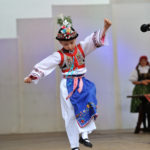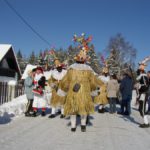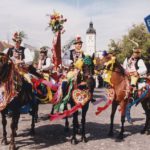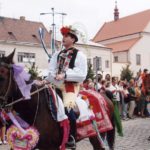UNESCO list: 2005, National list: 2009.
On November 25, 2005, the UNESCO Secretary General declared the Slovácko verbuňk a Masterpiece of the Oral and Intangible Heritage of Humanity. After the Convention for the Safeguarding of the Intangible Cultural Heritage of Humanity was adopted and 30 countries acceded to it, the Masterpieces project was suspended and transformed. The abovementioned Convention established two new lists of elements of the intangible culture – the Representative List of the Intangible Cultural Heritage of Humanity, and the List of the Intangible Cultural Heritage in Need of Urgent Safeguarding.
Reprezentativní seznam - Nominační dokumentace "slovácký verbuňk" verze CZ ENG version
Národní seznam - Nominační dokumentace "slovácký verbuňk"

The Slovácko verbuňk is a male dance of hopping nature. It is an improvised dance. It is special for its character, as despite being danced mostly in a group, each of the dancers dances for himself, expressing where he comes from and his individual dancing skills and nature. Verbuňk is danced with a certain type of songs, the so-called New Hungarian songs prevailing since the second half of the 19th century.
The name of the dance is derived from Werbung, a German word meaning recruiting, hiring, signing up, and from the practice of military service recruitment performed in the Czech lands until 1781 under the participation of professional military dancers, whose expression seems to have been one of the impulses for the creation of the dance.
In the Czech Republic, verbuňk has spread solely in the ethnographic area of Slovácko where it is or was also called with different names – cifra, cifrování, cifruňk, čardáš, čardášování, verbování, skákání, grepčení (grebčení).
Slovácko verbuňk usually consists of three parts: the dance begins with lead singing, whereby the dancer´s motion, if he does not stand in a semicircle together with the others, is very individual; after that, there follow a slow dancing part and then a fast dancing part which is a free motion composition with a very individual atmosphere.
Verbuňk was preceded by lad´s dances as well as other forms of motion, from which it gradually evolved. These forms included competition dances for who jumps higher, an individual male expression in rotating dances, and – probably especially – adorned walking of men in parades and ceremonial door-to-door processions, and maybe even other dances with competition elements. The spread of the new Hungarian songs might have been another impulse. The ethno-choreologists think verbuňk was formed as an independent dance in the second half of the 19th century, and it has evolved into six regional types in the 20th century.
According to the current state of research, it is possible to speak about six types of Slovácko verbuňk:
- from the Strážnice area
- from the Kyjov area
- hanácko-slovácký type from the Hustopeče and Ždánice areas
- „horňácký“ type from the Velká nad Veličkou area
- „uherskohradišťský“ type from the Uherské Hradiště and Uherský Brod areas
- “podlužácký” type from the Břeclav area
Slovácký verbuňk still performs several functions and it features great emotionality which is related to the fact that it is an improvising dance, not bound by strict choreographic rules and therefore giving more space to spontaneity. Originally, dancing this dance, the conscript said goodbye before military service, and compensated the great psychological tension and negative emotions resulting from the forthcoming departure to the military service, though showing simultaneously that he is capable of military service and striving to make an impression on the opposite sex. Therefore the psychological, the competitive and the erotic functions dominated in the dance. The dance was gradually adopted by other male members of the community, too, and the dance was progressively incorporated in other occasions of folk life, acquiring new functions. The ceremonious function became a very important one, then the expressing of the character, the immediate mental and physical condition of the dancer, and his identification with the village or the community.
Currently, the ceremonious function further develops – verbuňk is part of ceremonious parades and the whole complex of the kermes customs. It is danced in the parade of domestic young people, when the stárek is welcome in front of his house; at the beginning and at the end of the kermess dance party each group of boys coming from other villages is honoured by being given an occasion to dance verbuňk in front of all those present. The competitive function has remained preserved as the dancers compare their performances between each other. As a new function, the verbuňk expresses an affiliation to that group of young people who have positive active relation to the heritage of traditional folk culture.
In order to perform verbuňk excellently, the interpreter has to have several skills. Singing and the purity of intonation ranks first, furthermore it is necessary to manage the dialect and use it correctly. A good verbuňk dancer is also assumed to have a good knowledge of the song repertoire, i.e. texts and melodies used at the dance. As regards movement skills, the demanding nature, the number, proper sequence and level of performing dancing elements and figures are important. The dancer has to manage space arrangement, dance composition and gradation. Slovácko verbuňk is a unique expression of human creativity which is manifested by the fact that it has developed into six original regional types at quite a small area that Slovácko (Moravian Slovakia) occupies within Moravia, using the same dancing motifs (jumping up, jumping over, jumping aside, heel steps, heel clicking, stamping, handclapping, knee bending, leg stretching out and backwards, etc.) though usually performed in a different way and with a different intensity, frequency of occurrence, positioning of legs and sometimes also hands and the posture during the dance. These types have been preserved until the present and are further developed. If the dancer wants to be accepted by the community within which he acts, he must observe its regional type and be able to develop it in the spirit of the type. Slovácko verbuňk’s uniqueness consists in its complexity: each dancing performance is actually a unique creation. The dancers themselves perceive verbuňk quite emotively and, as they did in the past, they appreciate excellent verbuňk dancers even these days.
The contests in verbuňk dancing began already at the first festival in Strážnice, however, they ceased to exist after several years. They were renewed only in 1986. The Contest for the Best Dancer of Slovácko Verbuňk begins with regional rounds, its finale takes place at the International Folklore Festival in Strážnice. This Contest enjoys great interests among the visitors to the Festival, and for this reason, a visitor poll is conducted whose winners are mentioned in the following overview.
Winners of the Contest for the Best Dancer of Slovácko Verbuňk
The inscription of Slovácko verbuňk on the list of Masterpieces of the Oral and Intangible Heritage of Humanity is an extraordinary event for the Czech Republic. However, it brings a lot of measures and obligations to which our country obliged in the “action plan” which was an integral part of the nomination. In the archives of the National Institute of Folk Culture, you can find two sets of copies of the documents submitted in Paris (one in English and the other one in the Czech language). The above action plan is supposed to ensure the safeguarding of the Slovácko verbuňk for coming generations. If this is the case, the endeavours and goals of UNESCO, the Ministry of Culture, the National Institute of Folk Culture, and of everybody who took part in the preparation of the nomination, will be accomplished.
UNESCO list: 2010, National list: 2009
The village door-to-door processions and the masks associated with them in the Hlinecko area are part of a tradition that has survived in the active subconscious mind and that has been practised to date. The village Shrovetide processions in the Hlinecko area express traditional interests of the originally rural community: rich harvest, prosperity of livestock and farmyard, and health of family. They are even associated with the magic ensurance of fertility. The knowledge about the original functions of Shrovetide processions and masks in the villages of the Hlinecko area has survived to date even though their social and entertainment functions predominate at the first glance now.
Reprezentativní seznam - Nominační dokumentace "Vesnické masopustní obchůzky a masky na Hlinecku" verze CZ ENG version
Národní seznam - Nominační dokumentace "Vesnické masopustní obchůzky a masky na Hlinecku"

Descriptions of this element have survived from the mid-19th century. We can find them for example in chronicles of the villages of Holetín, Vortová, and Ždírec stored at the State District Archives in Chrudim. Karel Václav Adámek in his monograph Lid na Hlinecku [The People in the Hlinecko Area] (Praha, 1900) described the village Shrovetide door-to-door processions, masks, hospitality and rhymes of masks, as he captured them at the end of the 19th century. Based on these sources we can find out that the course and the form of the village Shrovetide door-to-door processions in the Hlinecko area have changed only slightly to date. The changes reflected by the village Shrovetide door-to-door processions in the Hlinecko area, as compared with the 19th century, are as follows: the number of locations in which the Shrovetide door-to-door processions take place has been reduced since the 1960s. The date of the event is another visible change – since the end of the 1960s, the processions have been held on the nearest Saturday or Sunday before Shrovetide Tuesday. Some of materials used to make Shrovetide masks have been replaced by other ones (some natural materials have been replaced by the artificial ones), the huts and caps worn by several masks are “decorated with pictures of scantily dressed women”; some props used by the masks have changed. The number of masks in the group of the “Black Mask” has increased. Until the early 1950s, there was only one mask in the group, now there are three or four masks.
The procession itself is preceded by preparations: it is necessary to ensure music, refreshment, and in particular to make masks. In the morning, currently on the last Saturday or Sunday of Shrovetide, the masks gather in a place and in a procession, they go to the mayor to ask him to permit the door-to-door procession. After having been given the mayor´s consent, the masks go from door to door, they dance in front of the inhabitants and contact the onlookers with words and gestures. They are given usual refreshment outside each house (doughnuts, open sandwiches, alcoholic drinks) and a financial fee. Its amount depends on the habits in a particular community. The procession is accompanied by a brass music band with a clarinet, a flugelhorn, a trombone and percussion instruments. The procession is closed with the ritual called “Killing of the Mare” which takes place in a place known in advance. During this ritual, the mare is condemned for its alleged sins. The judgment and the mare´s testament are read by one of the masked men. In a humorous form, he responds to different events in the village and society (increasing prices, unemployment). At the end of the reading, the mare kneels down, the masked man removes its cap, which means that the mare is symbolically executed. It falls to the ground and does not move. Other masks make a round around it, lay their caps on the ground and move in the circle, accompanied by sad music. After the end of the song, the masked man gives the mare some alcohol. The mare comes to life again, springing up. Then a funny dance of the masks with the onlookers follows. This act represents the essence of the Shrovetide door-to-door processions: the symbol of death (winter) and new life, resurrection (spring). The follow-up evening dance party bids farewell to the cheerful Shrovetide period.
UNESCO list: 2011, National list: 2009.
The Ride of the Kings is – as an annual custom – a ceremonious horseback procession of boys, or men in some places, who have a king – a teenage boy dressed in women´s festive folk costume – among them. The King is accompanied by his guards (aides) – riders of the same age as the rest of the cavalcade is, however, the aides are dressed in the same women´s folk costumes, as the King is, and they hold unsheathed sabres in their hands to protect the King. The cavalcade on decorated horses travels around the village, it stops at houses and the riders chant short rhymes addressing the domestic people and outsiders. The rhymes can be complimentary, humorous or even pejorative and the riders comment positive or negative character traits of a person concerned, or his or her physical appearance. The person at whom a rider from the cavalcade calls out is expected to donate some money to the rider.
Reprezentativní seznam - Nominační dokumentace "Jízdy králů" verze CZ ENG version
Národní seznam - Nominační dokumentace "Jízdy králů"

The not exactly clear origin of the ride of the kings allowed the erudite researchers to develop theses about the original form of the ritual, and its functions. The most distinctive element in the ritual can be related to initiatory rites as well as rites having a protective function with the aim to ensure successful farming through magic practices and means. The explanations that speak about the remnants of pagan rites and rituals of pre-Christian Slavs, which changed over centuries, seem to be at the closest to the truth. The custom of the ride of the kings at Pentecost (Whitsuntide) was widespread and carried out, in different forms, not only in Moravia, but also in Slovakia, Silesia, Bohemia, Poland and Ukraine.
Historical reminiscences regarding the ride of the kings are emblazoned with interesting, impressive and authentic-looking legends and tales. One of them considers the custom to be a folk parallel to medieval knight´s games and to be based on festive parades held during knight tournaments. Other explanations are based on an assumption that the custom takes place to commemorate the pursuit of the king. The most frequent assumption proceeds on a historic event from 1469 and a story about the chase of King Matthias Corvinus. King Matthias´s troops are said not only to have been repelled – after an unsuccessful siege of the town of Uherské Hradiště – with the invited aid of Jiřík from Poděbrady, but even to have suffered a defeat near the village of Bílovice. King Matthias had to flee from the battlefield. To preclude incarceration and to save his life, he had to escape to the nearby town of Uherský Brod. The victorious troops pursued him to this town. He is said to have been led through a secret corridor, in the guise of a girl, out of the town, and to have escaped to Hungary. The ride of the kings is supposed to have been commenced in commemoration of this event. And maybe to make this legend more credible, a supplement is added saying that the king from the current ride is also dressed in girl´s folk costume and he holds a rose in his mouth to avoid his male voice betraying him, and he is accompanied by a cavalcade to guard him.
Until the mid-1930s, the ride of the kings took place regularly in many villages in south-eastern Moravia. This custom was that living that the people considered it to be a natural part of the Whitsuntide, without current opulence. These days, the ride of the kings is regularly organized in several locations only. In Europe, there is no other corresponding parallel to the ride of the king as a Pentecost ritual at the turn of spring and summer, and for this reason we can speak about exceptionality and importance of this custom as a unique witness to a living cultural tradition in the Czech Republic.
UNESCO list: 2010, National list: 2009
Falconry is a special way of hunting wild quarry using trained birds of prey, in particular falcons, hawks and eagles, and it also includes other activities the falconers do, mainly breeding young birds, protection of birds of prey in their natural habitat, and education. Historically, it is a traditional specific field of hunting which uses its own methods, has its own animals, quarry and philosophy.
Reprezentativní seznam - Nominační dokumentace Sokolnictví - žijící lidské dědictví verze CZ ENG version
Národní seznam - Návrhový a evidenční list "Sokolnictví - umění chovu dravců"

This way of hunting was originally used as a way of obtaining food, but its meaning changed over times. In the Middle Ages, it served rather to entertain the nobility, while nowadays, falconry is understand as part of game management in our country, especially as part of gamekeeper tradition in terms of historical way of hunting.
The contemporary falconer, due to changing role falconry played in the history, is a friend of the birds of prey, who was and still is engaged in the protection of the birds of prey. Injured birds of prey can find professional help at his; and if it is possible, the falconers return the birds of prey back to the nature.
Falconry was well-known already in the era of the Great Moravian Empire and it is substantiated historically and archaeologically in the 8th and 9th centuries. From that time a bronze guard on the bell with the motif of a walking hunter with the bird of prey, a “bird´s” buckle and a silver relief with a falconer on horse were found as archaeological finds. The latter one has become a symbol of the Czech Club of Falconers. A document on the foundation of a settlement called Sokolí Dvůr [Falcon Courtyard], today´s Sokolov, comes from the 13th century. The settlement near the royal castle of Loket was a seat of royal falconers who could train their bird of prey there. The professional falconers, who were employees of noble lords, bred the birds of prey, trained them and introduced them during hunts. They occupied a privileged position among other serfs and they were well paid. They used to live near the lord´s seats and their settlements often became a basis for later villages and towns. One of them is Sokoleč near the town of Poděbrady, which was built for the royal falconers. The falconry survived there until the second half of the 16th century; then the falconers and their birds of prey lived in Poděbrady, in a special house called “sokolárna - falcons´ house”. The probably last falconer died in the Poděbrady domain in the mid-17th century. The period of decline beginning in the second half of the 18th century moved the birds of prey from the hands of nobility to the hands of their employees - gamekeepers who continued in keeping birds of prey and owls for their pleasure.
The modern history of falconry commenced in the 1920s thanks to Bedřich Mensdorff Pouilly who revitalized the tradition of falconry through hunting with hawks and falcons, and made it popular in his expert articles. The further promotion of falconry came only after 1945, to which contributed MUDr. Jiří Brdička who bred the birds of prey, and Svatopluk Doubrava in the late 1950s, whom Jan Kumbera and Ivan Maroši joined later. Falconry began to arouse interest mainly with young gamekeepers. This interest led to the foundation of the Club of Falconers. The contemporary falconry does not mean any more just hunting. It also includes education as well as introduction of the birds of prey, their biology and position in the nature to the wide public, protection of the birds of prey and their professional use for the protection of airports or vineyards. The professional falconers working at the airport with their birds of prey often prevent incalculable damage caused by plane crash after a collision with bird. The professional falconers also educate those interested, as they demonstrate the work with and of the trained birds of prey, doing an excellent amount of work in this realm
.
The common Czech-Slovak nomination “Puppetry in Slovakia and the Czech Republic” was inscribed on the UNESCO Representative List of the Intangible Cultural Heritage of Humanity at the 11th session of the Intergovernmental Committee for the Safeguarding of Intangible Cultural Heritage in Addis Ababa (Ethiopia) on 1st December 2016.
Puppet theatre is an integral part of theatre tradition in Slovakia and the Czech Republic. It is among the important and still living and developing elements of the intangible cultural heritage of both nations. This cultural phenomenon was inscribed on the Representative List of the Intangible Heritage of Slovakia in 2013, and one year later also on the List of the Intangible Elements of Traditional Folk Culture of the Czech Republic.


















